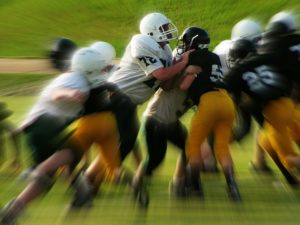
Heartbreaking stories of catastrophic football injuries
Over the last decade, there have been an average of three deaths each year, reportedly attributed to high school football injuries, according to one survey. Most recently, a high school football player in Illinois, Andre Smith, died October 23 after suffering “blunt force head injuries,” during a football game. He hit his head during the final play of the game, walked off the field, and later collapsed. Kenney Bui, a student at Evergreen High School near Seattle, died October 12 after suffering a traumatic brain injury during a game. Ben Hamm, a high school student in Bartlesville, Oklahoma, was rushed to the hospital with bleeding in his brain, following a football injury. He fell into a coma and later died on September 19th. These are only a few examples of the tragedy of catastrophic sports injuries.
The higher risk of catastrophic injury in high school football
According to a study published in the American Journal of Sports Medicine in 2007, high school football players suffer three times as many catastrophic injuries, including death, permanent disability, neck fractures and head injuries, as college players. Why? Because the developing brains of high school athletes are more vulnerable to catastrophic head injuries. Couple that with the lower skill level of many younger athletes, and the risk increases even more.
Other elements that increase the risk of injury even further
In addition to these factors, almost 70% of high school athletes who suffered concussions, still played despite their symptoms. Unfortunately, 40% of these athletes admitted that their coaches had no knowledge of their injuries. Another issue that increases the risk of catastrophic injury, in high school athletics, is the shortage of full-time athletic trainers at practice and games, often because of costs. Only 37% of public high schools in the United States have full-time athletic trainers.
What are we doing about it?
Each state and the District of Columbia now has some version of a sports concussion law, according to the National Federation of State High School Associations. Sports concussion laws requiring coaches to remove athletes with a suspected concussion from play. They also encourage or require concussion education programs for coaches. Keep in mind that the specifics of these laws vary significantly from one state to the next. Recently, the National Federation of State High School Associations recommended limitations be placed on the number of days per week that football coaches can hold full-contact drills.
The school’s duty toward its student athletes
Schools have a certain standard of care that must be met in protecting for student athletes under their care. As such, a high school has a legal duty to exercise reasonable care, which includes the duty of coaches and athletic trainers to exercise reasonable care for the health and safety of student athletes.
If you have questions regarding school sports injuries, or any other catastrophic injury concerns, call the Cottrell Law Office at (888) 433-4861.
Call Today for a Free Consultation (800) 364-8305


